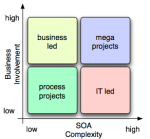
in his keynote presentaiton, Bret Dixon of BEA made an interesting comparison. One viewpoint is that of the single technology stack that has these characteristics:
- invest to reach homogeneity
- get everything you need from one vendor
- replace what you have
- periodic releases will give you enhancements
The other view point is a single service nertwork that has these characteristics:
- heterogenous products make up a network
- commitment to open standards
- uses different products to get needed functionality
- incremental increase in capacity and functionality
SOA means that the software the links applications become more important and are among the most improtant strategic decisions that a CIO makes.
SOA Initiation Patterns (click to enlarge) |
How do you role SOA out in your organization. Bret gives four patterns in the form of a 2x2 matrix that plots SOA complexity vs. Business sponsorship.
When sponsoship is low and the appetite for complexity is low, you have process projects that are characterized by having no CIO driven action plan. Starting points: identify a service with an opportunity for reuse. Design it, build it, and prove it out. This might be a skunkworks project.
When the CIO is involved, you can have more complex projects. Bret calls these IT-led projects. These are focused on infrastrucuture-based services. Start by creating an enterprise reference architecture and roll it out using in a multi-period roadmap. This requires that you establish an enterprise architecture group.
Bret Dixon of BEA Speaks of SOA Executive Forum (click to enlarge) |
High business sponsorship and low complexity results in business-led projects. In these cases, the IT team doesn't typically have the confidence of the business and the budget is limited. Often the CIO and team enthused about SOA. Start by finding a key business project. Identify a project with SOA needs. Architect it in a SOA manner by specifying services and demonstrate SOA capabilities.
With good business sponsorship and complex environmets, you end up with mega projects that results sweeping business change with significant IT impact. This doesn't happen very often and requires big budgets.
Governance and organization lessons
- Don't make the answer more difficult than it has to be.
- Don't engage in drastic reorganization, but put pressure in place to encourage alignment of business, development, and operations.
- The CIO has to be a leader.
- Align around specific objectives: speed, reuse, agility, etc.
The conclusion: get started! Know your entry point. Plan and manage holistically (multiple dimensiont and periods).






